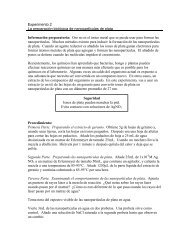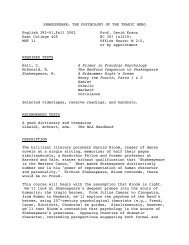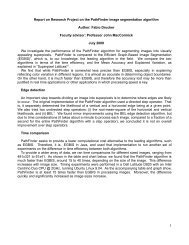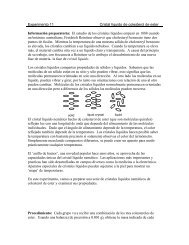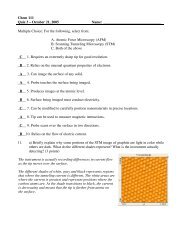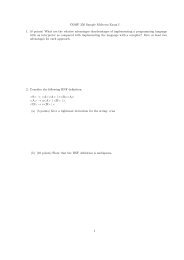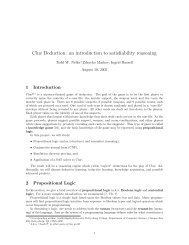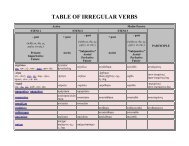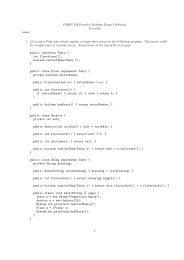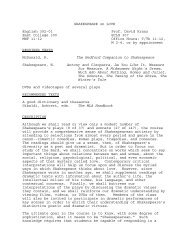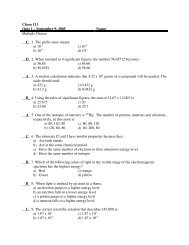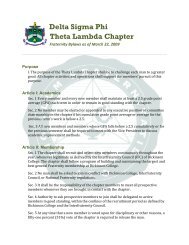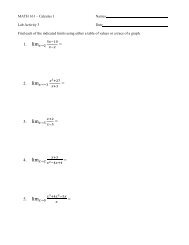COMP 356 Programming Language Structures Notes for Chapter 9 ...
COMP 356 Programming Language Structures Notes for Chapter 9 ...
COMP 356 Programming Language Structures Notes for Chapter 9 ...
You also want an ePaper? Increase the reach of your titles
YUMPU automatically turns print PDFs into web optimized ePapers that Google loves.
• a subprogram is active if it is executing, i.e. it has been called and has not yet returned. An executionof a subprogram is also called an activation of that subprogram.• a subprogram is recursive if it calls itself (directly or indirectly). Equivalently, a subprogram isrecursive if it can have multiple simultaneous activations.• a referencing environment is a collection of all names that are visible at a particular point in theexecution of a program. Since subprograms can have parameters and local variables, each subprogramintroduces a new referencing environment.The following diagram shows the role of an activation in mapping an occurrence of a stack-dynamicvariable to its value.scope activation statevariable declaration locationvaluenameoccurrence1 Parameter Passing MethodsParameter passing methods differ on whether parameters are used to transmit data to the subprogram (inmode parameters), from the subprogram back to the caller (out mode parameters) or both (inout modeparameters).Parameter passing can be implemented in several ways, including:• pass-by-value• pass-by-reference• pass-by-value-result• pass-by-name• macro expansionPass-by-value implements in mode parameters, while the others implement some <strong>for</strong>m of inout mode parameters.1.1 Pass-by-ValueUnder pass-by-value, only the value of the parameter is passed, and this value is placed in storage local tothe subprogram. Hence, any modifications made to the <strong>for</strong>mal parameter are not visible to the caller.For the prototype: P(x) (types omitted) and call: P(E), a subprogram call with pass-by-value parametersis executed as:x = E;body of Preturn result if necessaryFor example, in the following code sequence:2
x = 2;arr2[y] = 42;// copy-out phase*px = x;*py = y;copy(*parr2, arr2);Results:• arr[0] is 42 and arr[2] is unchanged• the final value of a depends on the order that the copy-outs occur in – it could be either 0 or 2. Thisis usually implementation dependent in languages that use pass-by-value-result.• in the presence of aliasing, pass-by-reference and pass-by-value-result can exhibit different behaviors.Another example:int g = 5;void foo(int x) {x = 3;g = 4;}...foo(g); // aliases g and x under pass-by-referenceUnder pass-by-reference, the value of g after the call to foo is 4. Under pass-by-value-result, the valueof g after the call to foo is 3 (because of the copy-out).Ada has three parameter passing modes:• in parameters (by value)• out parameters (just copy-out – also called pass-by-result parameters because they only pass in<strong>for</strong>mationfrom the subprogram to the caller). C# also has out parameters.• in out parameters (by value-result or by reference)In Ada 83, the use of value-result or reference <strong>for</strong> in out parameters is implementation dependent. Anyprogram that gives a different result depending on the implementation of parameter passing is defined to beillegal. However, in general compilers can not detect all aliasing, so Ada 83 programs are not portable. (!)The Ada 95 standard specifies that in out parameters of scalar types (numbers, booleans, ...) are passedby-value-result, and in out parameters of structured types (arrays, records, ...) are passed by-reference. Thisremoves the portability problem, and also avoids making copies of large arrays and records when they arepassed as in out parameters. However, Ada 95 programmers must remember two sets of rules <strong>for</strong> in outparameters.1.4 MacrosMany programming languages (C, C++, Scheme, ...) include macros, which are similar to subprogramsbut avoid the overhead of subprogram call and return. A call to a macro is executed as follows:1. the actual parameters are textually substituted <strong>for</strong> the <strong>for</strong>mals2. the resulting macro body is textually substituted <strong>for</strong> the call5
void spindleArray(int arr[][10][5]) {...}• this design does not allow one function to manipulate arrays of different sizes• alternative: pass a pointer to the array and the relevant dimensions of the array. For example:void spindleArray(int *arr, int dim2, int dim3) {...}This requires the programmer to per<strong>for</strong>m all address calculations (using pointer arithmetic) in thebody of spindleArray.In Ada, Java and C#:• multidimensional arrays are actually one-dimensional arrays of arrays• arrays include their size as an attribute (or instance variable)• hence, array index calculations can always be done, so multidimensional array parameters need notspecify any of the dimensions. Example (Java):void spindleArray(int[][][] arr) {...}2 Other Aspects of Subprograms2.1 Subprograms as ParametersIt is often useful to pass a subprogram as a parameter to another subprogram. For example, Scheme has amap function that takes a function and a list as parameters, and returns the result of applying the functionto every element of the list.Some design issues:• Can subprograms be passed as parameters?• Are subprogram parameters typechecked?• What referencing environment are calls to subprogram parameters evaluated in?By programming language:• Ada and Java do not allow subprograms as parameters.• Early versions of Pascal allowed subprogram parameters but did not typecheck them (when passed orwhen applied).• Later versions of Pascal require parameter and return types <strong>for</strong> subprogram parameters to be given,and so typecheck such parameters.• C and C++ allow pointers to functions as parameters. Function pointer types include parameter andreturn types, so such parameters are typechecked.In languages that use static scope, subprogram parameters are evaluated in the referencing environmentthat the actual parameter was defined in. This is always the global environment in C and C++, but isinteresting in Pascal and Ada, where function definitions can be nested. Evaluating subprogram parametersin the environment they are defined in is called deep binding.In languages that use dynamic scope (SNOBOL), subprogram parameters are evaluated in the referencingenvironment of the call to the subprogram parameter. This is called shallow binding.7
2.2 OverloadingA subprogram name is overloaded if it is bound to multiple subprogram definitions. The compiler must beable to determine (statically) which definition is meant in a particular call by the number and type of theactual parameters, and possibly by the return type.In Ada, the number and type of parameters and the return type (<strong>for</strong> functions) are used to resolveoverloading. Because Ada does not allow mixed-mode expressions, the return type of the function can beinferred from the context of the call.In C++, Java and C#, only the number and type of parameters are used to resolve overloading. Bothlanguages allow mixed-mode expressions and also allow functions to be called in statement contexts (wherethe return value is ignored), so the return type of the function can not be inferred from the context of thecall. Overloading is used heavily in these languages, particularly <strong>for</strong> constructors.It is illegal to omit default parameters that would make it impossible <strong>for</strong> the compiler to resolve overloading.For example, if a program had both of the following function definitions:double log(double x, int base = 10) { ... }double log(double x) { ... }then the call:log(2.3)is illegal. Note that in this case, the second version of log is useless (it can’t be called) and the defaultparameter can never be omitted.Note that overloading can simulate default parameters:double log(double x, int base) { ... }double log(double x) {return log(x, 10);}2.3 Generic SubprogramsA subprogram is generic (or polymorphic) if it can take parameters of different types on different activations.This can be implemented in several ways:• in dynamically typed languages (Scheme, LISP, Prolog, JavaScript, ...), arguments of any type canbe passed to any subprogram. However, type errors can result if the subprogram makes assumptionsabout the types of its parameters.• in languages that allow overloading (C++, Java, Ada, ...), an overloaded subprogram name can beviewed as polymorphic. This <strong>for</strong>m of polymorphism is called ad hoc polymorphism.• in languages with parametric polymorphism (C++, Ada, Java 5.0, ...), subprograms can have typesas parameters. Typically, the type parameters must be used first to instantiate the subprogram, andthen it can be called with the remaining parameters.An example of defining and using a C++ template function:#include #include template EType findMax(EType arr[], int len) {EType res = arr[0];<strong>for</strong> (int i = 1; i < len; i++) {if (arr[i] > res) res = arr[i];}return res;8
}int main() {std::string sarr[] = {"an", "array", "of", "strings"};int iarr[] = {5, 4, 3, 2, 1};}std::cout
}}T max = c[0];<strong>for</strong> (int i = 1; i < c.length; i++) {if (c[i].compareTo(max) > 0) max = c[i];}return max;// using the ? wildcard - any Collection of any "subclass" of Comparable// can be passed to this methodpublic static Comparable findMax3(Collection



